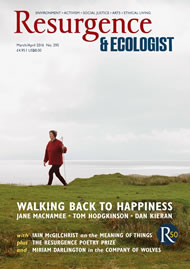The international conference – COP21 – that met in Paris in December produced the best I could have hoped for: an agreement signed by 196 nations. That we are now working together towards a commonly agreed goal of reducing the rise in global temperatures to 2°C marks the beginning of the real race against climate change.
But beyond the diplomatic declarations of success, can the Paris Agreement’s aims be met? Last year I attended the Findhorn International Forum on Sustainability, looking to hear from business leaders how they thought world carbon reductions could be achieved. The mood was buoyant, with positive stories from big business and investment.
Sales of sustainably branded products are growing faster than other lines, and what may have begun as greenwash is becoming more genuine. Guy Bigwood, sustainability director of MCI, the world´s largest integrated events and communications company, with its headquarters in Geneva, explained how pressure on big businesses is working: “Activists from the California-based charity Forest Ethics staged a campaign against 3M, manufacturer of Scotch Tape and Post-it notes, at the Sustainable Brands Conference in San Diego last year,” he told me. “Consequently, 3M invited Forest Ethics into dialogue and [they] are now working together to tackle deforestation.”
An exciting development of the last decade is “impact investing”, whereby philanthropists and foundations invest in companies that offer environmental and social benefits as well as financial returns. This replaces the old model of investing in activities with questionable ethics but high returns and then streaming the proceeds into ethical activities. Dana Lanza, CEO and founder of Confluence Philanthropy, a network of organisations that practise mission-related investing, told me: “A fundraising evening at the White House last June raised $4 billion for environmental projects. However, investors are struggling to find enough small, de-risked, environmental businesses to invest in.”
“We can do it” is very much the tone of Zero Carbon Britain, published by the Machynlleth, Wales-based Centre for Alternative Technology (CAT), which lays out a comprehensive decarbonisation plan for the UK. Broadly speaking, a third of national emissions come from heating homes and offices, a third from transport, and a third from industry. The reduction strategies outlined in the report appear conservative and achievable. Buildings can be insulated to reduce heat loss by 60%. Transport emissions can be reduced by 40% by cutting out unnecessary distribution, and by a further 40% through increased vehicle efficiency such as the use of hybrid cars and buses.
Modern industrial agriculture is recognised as a large source of CO2 emissions. The CAT report addresses emissions from meat production by suggesting “more quality, less quantity” and “more white, less red meat”. This change, the report says, would result in both a healthier diet and significantly lower emissions.
Overall, if implemented, the CAT plan would reduce Britain’s energy use by 60%. It advocates meeting the remaining need with renewable energy supplies. Given that renewables produced 25% of the UK’s electricity when several power stations went offline on 19 October 2014, and already meet 60% of Germany’s electricity needs in many months of the year, this seems realistic. Notwithstanding political hiccups, such as recent government cuts to renewable subsidies, following the suggestions in Zero Carbon Britain could make Britain carbon neutral by 2030.
But is this enough? We need to ensure that by 2050 we have genuinely succeeded in averting catastrophic climate change, because there won’t be a second chance. Some of the assumptions that form the basis of most decarbonisation strategies, including Zero Carbon Britain and the United Nations Framework Convention on Climate Change (UNFCCC), raise questions.
First, holding the global temperature rise to 2°C has been the globally accepted target to avoid “dangerous climate change”. But recent evidence now suggests that this is in fact the threshold between “dangerous” and “extremely dangerous” climate change. In light of this, some island states are calling for targets that would limit the rise in temperature to 1.5°C.
Second, current targets are designed to give us an 80% chance of keeping global temperature below 2°C. This is a probability worse than the odds in Russian roulette.
Third, in order to play an equal part in achieving the 2°C target, the required UK carbon budget from 2015 to 2050 is 8.4 billion tonnes of CO2 equivalent (which includes other greenhouse gases, such as methane, adjusted for their global warming potential in comparison to CO2). But current UK targets would produce 15.8 billion tonnes of CO2 equivalent in that period – twice the recommended quota. (Current UK targets start from a base of emissions levels in 1990 and commit to a 12.5% reduction by 2012, a 40% reduction by 2030, and an 80% reduction by 2050.)
To summarise these three points, if Britain meets its current and legally binding commitment on cutting carbon emissions, it will only give us an 80% chance of achieving half the reductions required to place us on the border between dangerous and extremely dangerous climate change.
Peter Harper, Natural Sciences lecturer at Bath University, points out two further reasons that current targets are insufficient. “They only consider our emissions from 2010, rather than from the UNFCCC baseline date of 1990, and the massive emissions during the intervening 20 years need to be accounted for,” he says. “They also only include emissions from inside the UK borders, but they need to account for manufacturing and land-use change abroad for UK consumption. Taking all of these into account and starting from 1990, total UK emissions by 2030 are around six times greater than accounted for in Zero Carbon Britain. What we then see is that it is impossible to reach 2050 inside our carbon budget by activities inside our borders alone, and the UK will need to simultaneously invest in decarbonisation projects abroad.”
So, what would a safer plan look like? We can invest in all the same carbon-saving activities that we are employing nationally in other countries. For example, just as insulating your home in the UK offers a higher return than most other investments, insulating an office block in northern China will also have financial returns. And due to exchange rates, implementing carbon-saving measures abroad can be less expensive. Hence the investment potential of international decarbonisation should not be underestimated.
A forerunner of this is The Converging World (TCW), established by Bristol-based environmental entrepreneur John Pontin. TCW builds wind farms in India, sells carbon offsets in the UK, supplies affordable energy locally, and uses income from electricity sales to support local social projects: a win–win–win situation. Because these activities are saving resources, they fundamentally increase natural wealth.
Carbon offsetting and trading are essential to facilitate this process. Offsets have got a bad name from early projects such as the eucalyptus forests that were planted to sequester carbon dioxide but soon perished. However, there are many genuine offsetting activities that are guaranteed to work, ranging from small projects such as insulating schools in Tibet to larger projects such as investing in wind power in India to help it reduce its dependence on building coal-fired power stations.
Due to the fact that atmospheric CO2 levels are already too high, we also have to take another step. That is sequestration: activities that absorb CO2 from the atmosphere and store it in the ground or elsewhere. Fortunately there are several viable methods available. Because of the urgency of climate change and therefore the need for guaranteed success first time, the most prudent approach is to use tried and tested natural techniques.
Probably the largest global sequestration potential is in rich soil farming, whereby farming techniques and crops are chosen that optimise what plants do naturally: absorb CO2 and store it in the soil in the form of humus. A 2007 study for the Intergovernmental Panel on Climate Change estimated that, by adopting best practices, world agriculture could absorb 6–10 billion tonnes of CO2 per year, which would mitigate 20–35% of current global emissions.
Growing high-carbon-yielding crops for building materials and biochar also has great potential. This requires land, but in the same way that Zero Carbon Britain optimises British land use, releasing land for sequestration, this can be done globally. One example is miscanthus, otherwise known as elephant grass. Miscanthus is almost pure cellulose, and it is very good at absorbing CO2. Normally grown to burn for energy, it is also excellent for building. Zero Carbon Britain estimates that if buildings were designed specially to use miscanthus the process could mitigate a third of Britain’s carbon emissions in 2050. Miscanthus, like timber, can also be turned into charcoal, which when buried in agricultural land locks in CO2 and improves fertility. The Natural Environment Research Council has found that biochar reduces CO2 emissions from soil respiration.
Planting forests is the most obvious of the tried and tested sequestration techniques. The Green Belt Movement, set up in Kenya in 1977 by the activist Wangari Maathai, has planted over 50 million trees in Africa, covering nearly a quarter of a million hectares. Forests typically sequester over 7 tonnes of CO2 per hectare, so these efforts alone now sequester nearly 2 million tonnes of CO2 annually. Tree planting on desert peripheries could be the new activity for organisations such as Voluntary Services Overseas, with a significant contribution to carbon sequestration over the next 35 years.
Carbon saving at home and abroad will create increased activity and collaboration. Activity drives economies, collaboration promotes peace, and saving resources reduces the causes of conflict. I believe that the next three decades are going to require more intelligence, effort and collaboration than World War II. But what we must not miss is that meeting the challenge of climate change will address our economic and social problems at the same time. As both those business leaders I talked to at Findhorn and the Zero Carbon Britain report say, it can be done.
For more information on the Findhorn International Forum for Sustainability, email [email protected]








